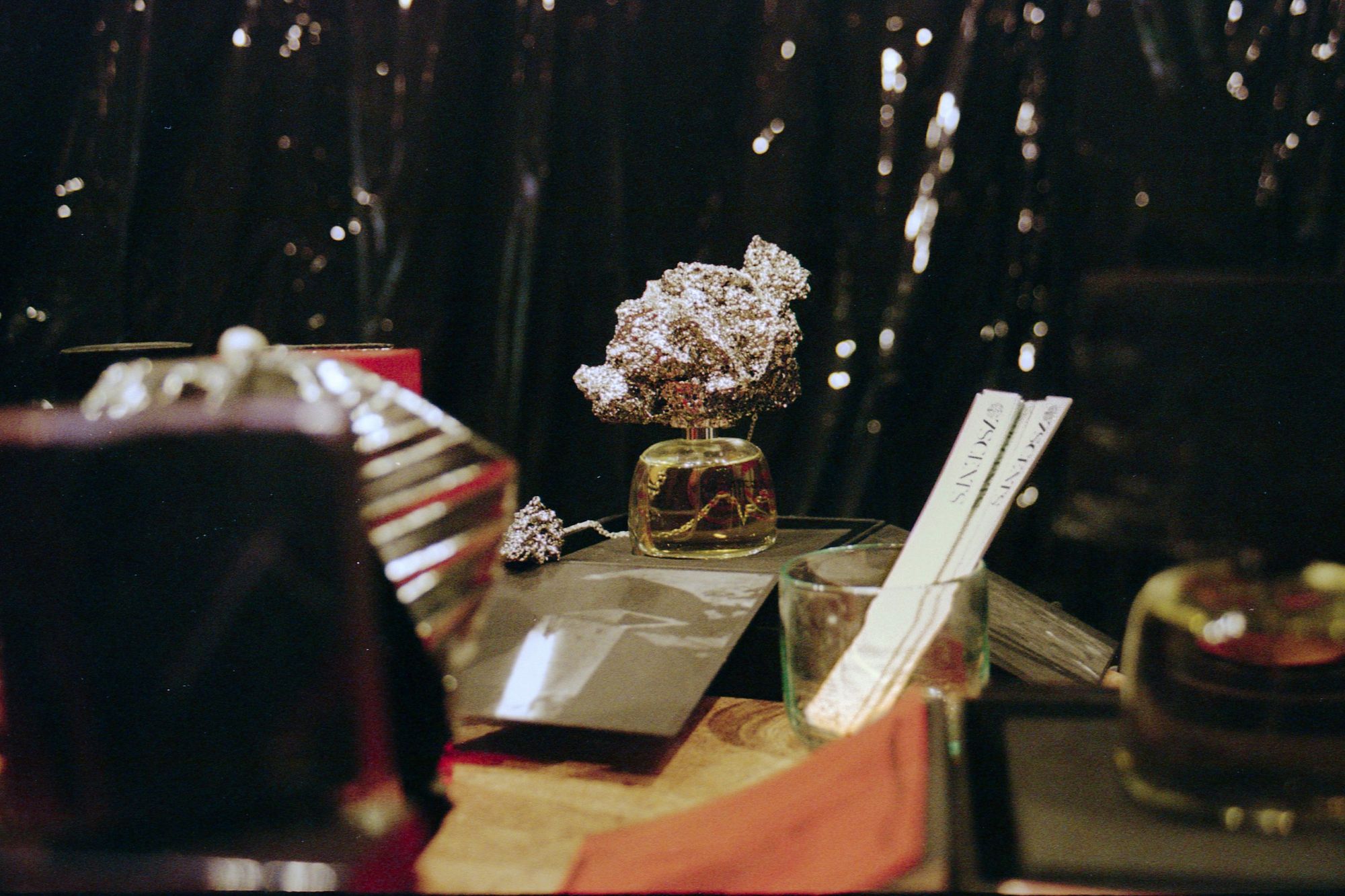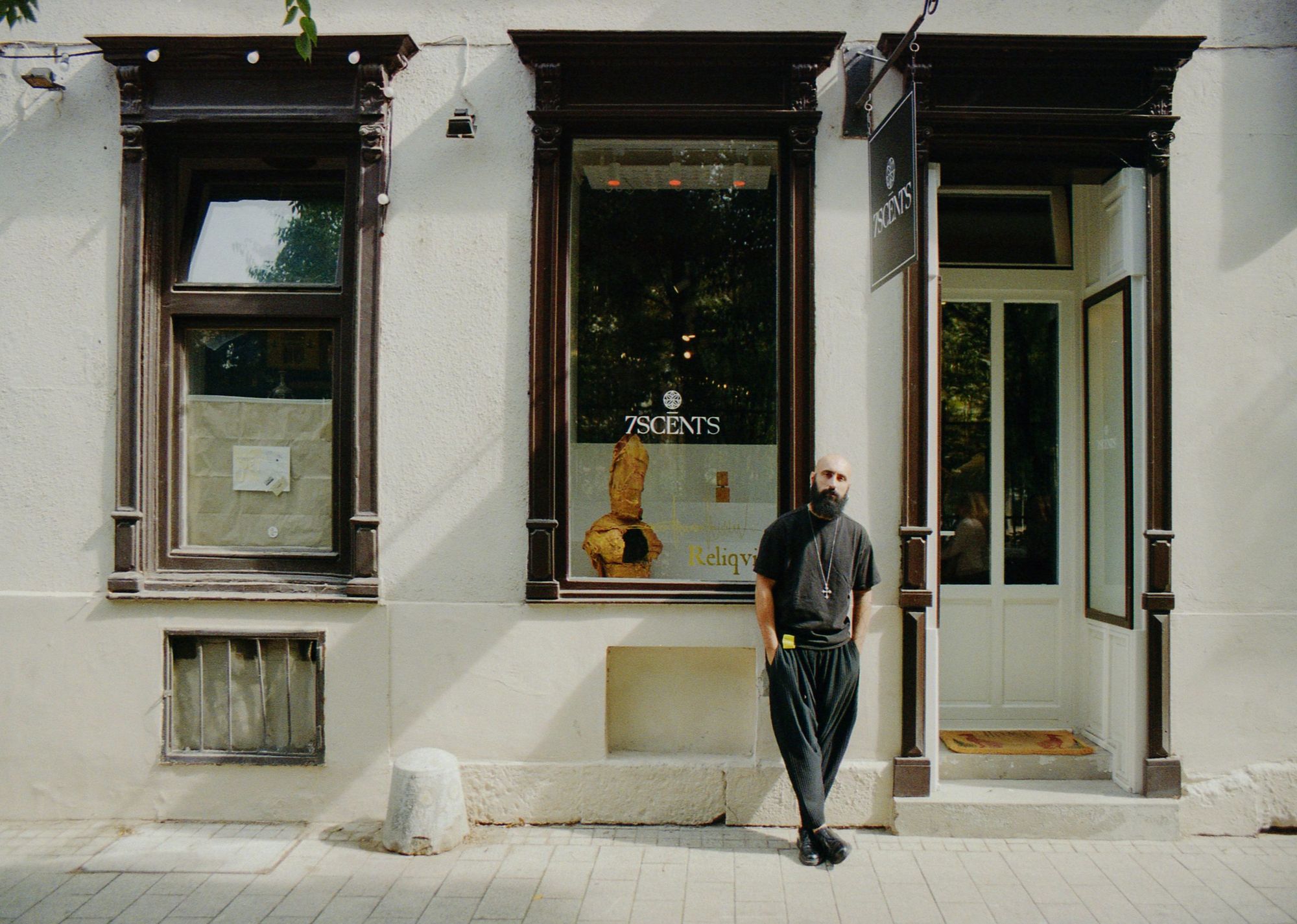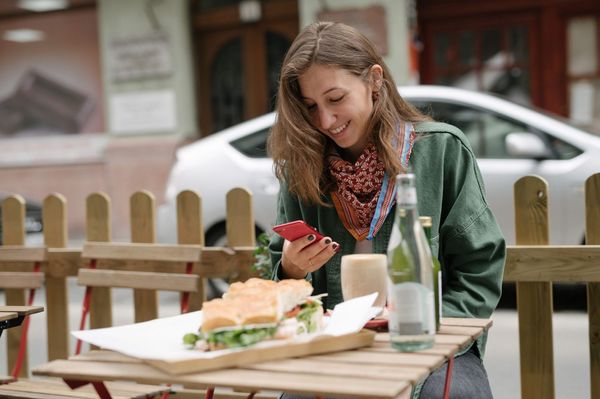The essence of sacred art is to forget the outside world and breathe in beauty in just a matter of moments. Italian artist Filippo Sorcinelli, organist, perfumer—and not least, the tailor of the pope—visited Budapest to present his latest scent, Reliqvia in the 7scents perfumery next to Károlyi Garden.
7scents is a fan of avant-garde, niche perfumes; in its repertoire, we can also find brands that have not been represented on the Hungarian market before. The otherwise refined space of the shop took on the characteristic world of Filippo Sorcinelli for a while, where the organ sound and the walls covered with black foil created a distinctive atmosphere. In this strange milieu, the artist told us about his exclusive collection of fragrances: the signatures of his perfumes are sometimes unsettling, astounding, but also sensual. The perfumer is inspired to create scents by special things like Notre-Dame’s organ, sacred elements, a scene from Ridley Scott’s well-known movie The Silence of the Lambs, but even profane phenomena like fog or even sexuality. In addition to scents, we also talked about chasubles, sacred art, creation, and the artistic creed of the complex individuality. Interview!

The Roman Catholic Church in Italy has a long history, and the society is also deeply religious, which also affects your artistic work. Please tell us about the beginnings: where does your personal connection to religion come from?
I think that religion is very important to us, Europeans, not only because of its spiritual aspect: Europe was formed and born in the cult of the Catholic religion, which is why we can say that religion is a social phenomenon here—our traditions are our own roots at the same time.
I have a fond memory that I always tell when it comes to this question. I may have been five years old when I accompanied my mother to one of Mondolfo’s largest churches, where she was regularly cleaning—in the meantime, she left me there to do anything freely. In those three hours she worked there, I discovered the beauty of the church and its art, the various pieces of furniture and textiles in the sacristy. I also found a closet there with a bunch of keys hiding next to the incense, which opened a dusty door. I walked up on the little stairs covered with spider web, where I discovered a metal and wooden monster standing on a pedestal. I tried to turn on its keyboard, but it didn’t work, so I kept trying when it started on its own: it started playing music. So from the perspective of time, this story seems a bit absurd: it contains the curiosity of a small child, which then became a thirst for knowledge for a young man. All of these things brought the fact that this medium became part of my being. That I am what I am today is due to this experience.
The name of your exclusive tailoring company, LAVS (Laboratorio Atelier Vesti Sacre), means “praise” in Latin and is responsible for the official liturgical attire of the Vatican. Among others, Pope Benedict and Pope Francis already wore pieces you made. How did this journey begin? How much creative freedom can you have in such a profession?
After finishing my musical studies in Rome, one of my dear friends called me on the phone, whom I hadn’t heard from for a very long time. “I want to tell you something: I will be a priest in six months,” he began. Instinctively, all I replied was, “Don’t buy any clothes!”. My brother and aunt had a small workshop in Mondolfo: bridal and other clothes for ladies were sewn here. I told them we were going to do something completely different now: make my friend’s first chasuble. We worked on it for about three months, which eventually became so successful that I realized I wanted to do it for a living.
And do I have freedom in this profession? I do, indeed. To the extent that I need to know certain rules that need to be respected and I also need to be aware of their importance. It is not just a piece of clothing, it is sacred wear: for one who believes in the sacraments, the vestments are of profound significance.

Italy is known to be one of the leading countries in fashion. As you have also mentioned, chasubles are made according to certain traditions, and some elements of the costume have a symbolic meaning. To what extent can we speak of “trends” in the strictly composed system of liturgical garments?
It’s a little hard to tell, but I think society also has some impact on the church and vice versa: it exists back and forth. Sacred art has repeatedly influenced the fashion industry, but also other areas: Karl Lagerfeld, for example, created a Byzantine-inspired collection for Chanel, but we can find examples of this in the repertoire of other big brands such as Versace and Dolce&Gabbana.
In contrast to the rapidly changing nature of the fashion industry, vestments are timeless: this impresses the industry and those who create fashion. Creators who make sacred art need to be aware that these productions have to tell a story for centuries because they are about something that is beyond them. Sacred art is not made for people, but rather to help them.
Pope Benedict and Pope Francis are known to be two different personalities, which is also reflected in their attire. Pope Francis does not believe in unnecessary splendor: he likes simplicity. How does this affect your work: a kind of relief or the opposite?
It’s an exceptionally challenging task. If something is simple, it doesn’t necessarily mean it’s dull or boring. An extract must be created from decorativeness that allows the essence of things to rise to the surface: that is, in fact, the core of beauty. Reaching back to noble simplicity—working with Pope Francis means that.

Let’s talk a little about your perfumer job as well. Although perfumes may seem like a modern invention, they were actually used primarily for religious purposes and rituals. You have recreated the atmosphere of temples and holy places in your UNUM collection. Although you intended your perfumes primarily for non-commercial purposes, they did embark on this journey. Why are scents important and what do they mean to you?
Scents are just as important to me as music. Neither music nor scents need to take physical form. They are like two siblings, they speak the same language: music and smell go through dimensions that don’t need to be touched, but we still feel them. In Italian, the word “sentire” also means the terms hear and feel. This phenomenon triggers a kind of “sea of emotions” in us that no other art branch can. Although the scents I create also speak of sacred things, I would rather say that UNUM is much more about emotions.
Why is the latest Reliqvia fragrance special? What is the background story?
Reliqvia is meant to symbolize relic guards. As we smell it, we can immediately feel that it is somehow superior to the other scents in the collection: it hides something valuable.
Like my previous perfumes, Reliqvia also has a special history. A few minutes from Mondolfo, in Senigallia, is a small church where I also work as an art director and organist. The Chiesa della Croce is one of the jewels of Italian Baroque; its special feature is that it is completely covered with gilded wood, inside there is a valuable painting. The work of art was painted in the late fifteenth century by a Urbino artist, Federico Barocci, and depicts the tombstone of Christ. In addition to this great treasure, the church hides other relics, all of which can be linked to the story of suffering. Reliqvia wants to frame this relic guarding in a synesthetic way.

Your artistic activity is very complex: you seem to pursue separate crafts, but your work as a perfumer, organist, artist, and tailor is strongly intertwined. How do you think sacred art can be renewed or prevail in the contemporary canon?
I don’t think sacred art should be renewed because then it would already become secular. In the case of commercial places or products, one cannot smell the same, listen to the same music, and behave in the same way as when entering a temple. This is the essence of sacred art: to forget the outside world and breathe in beauty in a matter of moments.
What new things can we expect from you in the near future? What are your plans?
My problem is that I have too many ideas. Several projects are underway: personal exhibitions, concerts, new scents—every day is something new for me.

Photos: Dániel Gaál
Filippo Sorcinelli | Web | Facebook | Instagram
7scents | Web | Facebook | Instagram

Favorite places #7 | Sári Győri

Sound as experience | Frontira x HYPE










